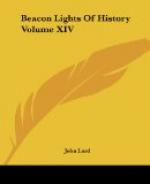One might have expected that the prince of pianists, being at the same time a composer, would do for the pianoforte what Bach had done for choral and organ music, Beethoven for the symphony, Schubert for the art song, and Wagner for the opera. But he could not, for Chopin had anticipated him. In only one direction was it possible to go beyond Chopin,—in that of making the piano capable of reproducing orchestral effects. This, Liszt achieved in his own works and his transcriptions. But, after all, the grandest pianoforte, while delightful as such, is but a poor substitute for an orchestra. Hence it was natural that Liszt should give up the pianoforte as his specialty and devote himself particularly to the orchestra.
In this domain he was destined to achieve reforms similar to those of Wagner in the opera. The “classical” symphony, like the old-fashioned opera, consists of detached numbers, or movements, that have no organic connection with one another. For the detached numbers of the opera Wagner substituted his “continuous melody;” and he provided an organic connection of all the parts by means of the “leading motives” or characteristic melodies and chords which recur whenever the situation calls for them. In the same spirit Liszt transformed the symphony into the symphonic poem, which is continuous and has a leading motive uniting all its parts.
There is another aspect to the symphonic poem, in which Liszt deviated from Wagner. In Wagner’s operas there is plenty of descriptive or pictorial music, but no program music, properly speaking; for even in such things as the Ride of the Valkyries, or the Magic Fire Scene, the music does not depend on a programme, but is explained by the scenery. In programme music, on the other hand, the scene or the poetic idea is simply explained in the programme, or else merely hinted at in the title of the piece. Crude attempts in this direction were made centuries ago, but programme music as an important branch of music is a modern phenomenon. Beethoven encouraged it by his “Pastoral Symphony,” and the French Berlioz did some very remarkable things in this line in his dramatic symphonies; but it remained for Liszt to hit the nail on the head in his symphonic poems. The French Saint-Saens followed him, rather than his countryman Berlioz; so did Tschaikowsky, Dvorak, and most modern composers, up to Richard Strauss, whose symphonic poems are the most widely discussed, praised, and abused compositions of our time.
To the great names contained in the preceding paragraphs another must be added,—that of an Italian. By an odd coincidence, Verdi was born in the same year as Wagner, 1813. But what is far more remarkable is that at the close of their careers, so different otherwise, these two great composers met again—in their music, Verdi as a Wagnerian convert. Up to his fifty-eighth year Verdi had written two dozen operas, all made up of strings of arias in the old-fashioned




